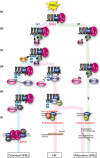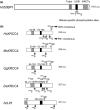Double-strand break repair-adox: Restoration of suppressed double-strand break repair during mitosis induces genomic instability
- PMID: 25287622
- PMCID: PMC4317954
- DOI: 10.1111/cas.12551
Double-strand break repair-adox: Restoration of suppressed double-strand break repair during mitosis induces genomic instability
Abstract
Double-strand breaks (DSBs) are one of the severest types of DNA damage. Unrepaired DSBs easily induce cell death and chromosome aberrations. To maintain genomic stability, cells have checkpoint and DSB repair systems to respond to DNA damage throughout most of the cell cycle. The failure of this process often results in apoptosis or genomic instability, such as aneuploidy, deletion, or translocation. Therefore, DSB repair is essential for maintenance of genomic stability. During mitosis, however, cells seem to suppress the DNA damage response and proceed to the next G1 phase, even if there are unrepaired DSBs. The biological significance of this suppression is not known. In this review, we summarize recent studies of mitotic DSB repair and discuss the mechanisms of suppression of DSB repair during mitosis. DSB repair, which maintains genomic integrity in other phases of the cell cycle, is rather toxic to cells during mitosis, often resulting in chromosome missegregation and aberration. Cells have multiple safeguards to prevent genomic instability during mitosis: inhibition of 53BP1 or BRCA1 localization to DSB sites, which is important to promote non-homologous end joining or homologous recombination, respectively, and also modulation of the non-homologous end joining core complex to inhibit DSB repair. We discuss how DSBs during mitosis are toxic and the multiple safeguard systems that suppress genomic instability.
Keywords: Chromosome segregation; DSB repair; NHEJ; homologous recombination; mitosis.
© 2014 The Authors. Cancer Science published by Wiley Publishing Asia Pty Ltd on behalf of Japanese Cancer Association.
Figures




Similar articles
-
How cancer cells hijack DNA double-strand break repair pathways to gain genomic instability.Biochem J. 2015 Oct 1;471(1):1-11. doi: 10.1042/BJ20150582. Biochem J. 2015. PMID: 26392571 Review.
-
Canonical non-homologous end joining in mitosis induces genome instability and is suppressed by M-phase-specific phosphorylation of XRCC4.PLoS Genet. 2014 Aug 28;10(8):e1004563. doi: 10.1371/journal.pgen.1004563. eCollection 2014 Aug. PLoS Genet. 2014. PMID: 25166505 Free PMC article.
-
53BP1: Keeping It under Control, Even at a Distance from DNA Damage.Genes (Basel). 2022 Dec 16;13(12):2390. doi: 10.3390/genes13122390. Genes (Basel). 2022. PMID: 36553657 Free PMC article. Review.
-
Polθ is phosphorylated by PLK1 to repair double-strand breaks in mitosis.Nature. 2023 Sep;621(7978):415-422. doi: 10.1038/s41586-023-06506-6. Epub 2023 Sep 6. Nature. 2023. PMID: 37674080 Free PMC article.
-
Give me a break, but not in mitosis: the mitotic DNA damage response marks DNA double-strand breaks with early signaling events.Cell Cycle. 2011 Apr 15;10(8):1215-21. doi: 10.4161/cc.10.8.15334. Epub 2011 Apr 15. Cell Cycle. 2011. PMID: 21412056 Free PMC article.
Cited by
-
DNA damage response during mouse oocyte maturation.Cell Cycle. 2016;15(4):546-58. doi: 10.1080/15384101.2015.1128592. Epub 2016 Jan 8. Cell Cycle. 2016. PMID: 26745237 Free PMC article.
-
DNA repair in cancer initiation, progression, and therapy-a double-edged sword.J Appl Genet. 2019 Nov;60(3-4):329-334. doi: 10.1007/s13353-019-00516-9. Epub 2019 Aug 30. J Appl Genet. 2019. PMID: 31468363 Free PMC article. Review.
-
A Novel Model Based on Genomic Instability-Associated Long Non-Coding RNAs for Predicting Prognosis and Response to Immunotherapy in Patients With Lung Adenocarcinoma.Front Genet. 2021 Oct 29;12:720013. doi: 10.3389/fgene.2021.720013. eCollection 2021. Front Genet. 2021. PMID: 34777461 Free PMC article.
-
Integrating the DNA damage and protein stress responses during cancer development and treatment.J Pathol. 2018 Sep;246(1):12-40. doi: 10.1002/path.5097. Epub 2018 Jul 19. J Pathol. 2018. PMID: 29756349 Free PMC article. Review.
-
Baicalin hydrate inhibits cancer progression in nasopharyngeal carcinoma by affecting genome instability and splicing.Oncotarget. 2017 Dec 4;9(1):901-914. doi: 10.18632/oncotarget.22868. eCollection 2018 Jan 2. Oncotarget. 2017. PMID: 29416665 Free PMC article.
References
-
- Chapman JR, Taylor MR, Boulton SJ. Playing the end game: DNA double-strand break repair pathway choice. Mol Cell. 2012;47:497–510. - PubMed
-
- Bogue MA, Wang C, Zhu C, Roth DB. V(D)J recombination in Ku86-deficient mice: distinct effects on coding, signal, and hybrid joint formation. Immunity. 1997;7:37–47. - PubMed
Publication types
MeSH terms
Substances
LinkOut - more resources
Full Text Sources
Other Literature Sources
Miscellaneous

